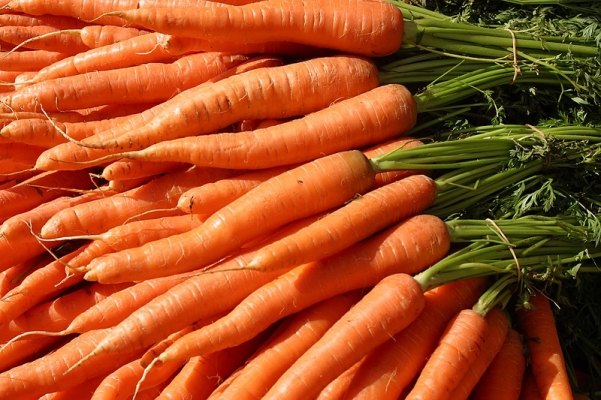Early Nantes: Cylindrical roots, with small peaks, orange color flesh, variety gets ready in 110 days. It gives an average yield of 62.5-80qtl/acre.
Chantenay: Fruits are sharp from end but front part is closed, orange in color, gets ready in 110-130 days. It gives an average yield of 84-94qtl/acre.
Pusa Yamdagni: Roots are long and less sharp, medium peak, orange color, gets ready in 80-120 days. It gives an average yield of 80-105qtl/acre.
European varieties:
European Carrot: This variety has attractive roots which are cylindrical, medium long (18-20cm), soft and orange in color, medium peak. The variety is rich Keratin content. The variety gets ready in 100-110 days. It gives an average yield of 94-115qtl/acre.
Asiatic varieties:
Pusa Kesar: Long roots, orange color, sharp and gets ready in 80-100 days. It gives an average yield of 83-105qtl/acre.
Other state varieties:
PC 34: Red color variety having dark green leaves. Length of root is about 25cm and root diameter is about 3.15cm.TSS content is 8.8percent. It is ready for harvesting in 90days after sowing. Gives average yield of 204qtl/acre.
Punjab Black beauty: Roots are purple black with dark green leaves. It is a rich source of anthocyanins and phenols which protect from cancer. TSS content is about 7.5%. It is ready for harvesting in 93days after sowing. Gives average yield of 196qtl/acre. Fresh carrots are used for salad, juice, pickle and Kanji.
Exotic Varieties: 1) USA - Red cored chantenay, Danvers half long, Imperator. 2) New Zealand: Akaroa long red, spring market improved, Wanganui giant. 3) Japan: Suko 4) Belgium : Belgium white 5)Netherlands: Early Horn 6) Australia: Red elephant, western red, yellow 7) France: Chantenay, Nantes, oxheart.
Pusa Kesar: Red colored carrot variety, developed at IARI, New Delhi. It is ready to harvest in 90-110days and gives average yield of 120qtl/acre.
Pusa Meghali: Orange colored carrot variety, developed at IARI, New Delhi. Gives average yield of 100-120qtl/acre.
New Kuroda: Hybrid suitable for plain as well as hilly areas.











